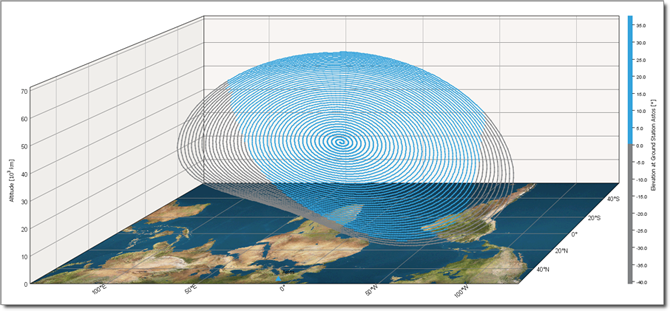
LOTOS Special Features
Hybrid TransfersSometimes the mass of a spacecraft is quite high in comparison to the thrust magnitude of the equipped electric propulsion system demanding a very long orbit transfer. In such situation mission designers and spacecraft engineers might think about an additional chemical orbit boost before the low-thrust orbit-raising starts. For fast assessments and efficient mission planning LOTOS 2 supports the evaluation of hybrid transfer scenarios. Up to three user customizable chemical burns are supported. Besides the optimization of the duration of each burn, an additional out-of-plane component can be included in the burns for changes of the inclination. Two constraints are provided to limit the maximum total transfer duration or to define a minimum periapsis radius required after the chemical orbit-raising. The second constraint is very handy to minimize the dwell time in the hazardous radiation belt. For easy first iterations of possible transfer scenarios, the hybrid transfer feature can be used with the built-in batch-mode inspector for detailed studies minimizing the user interaction. Productive processing is guaranteed by the state of the art global optimization method MIDACO, an ant colony optimization algorithm. A dedicated one click report rounds out this optional feature. Control Centre ModeMinimizing the efforts of spacecraft operations is one essential step towards full autonomy of spacecraft orbit transfers. To support spacecraft operators during the LEOP of an electric orbit-raising satellite, LOTOS can be upgraded with this optional feature. When using it, an already computed orbit transfer is required as reference trajectory. It can be taken from previous mission analysis activities or control centre mode optimizations. Once the spacecraft state (position, velocity, epoch and mass) is updated after an autonomous spacecraft transfer, for example, the software automatically identifies the location on the reference trajectory which is closest to the current spacecraft state. The remaining orbit transfer is then re-optimized while the previously computed trajectory is retained as far as possible. Any deviation in the current spacecraft state wrt. its reference is minimized for the remaining transfer. Further, the trajectory is split so that the next transfer arc might be optimized for example with constrained slew rates. Finally, the optimized attitude profile is written in a dedicated output file which can be directly processed and uploaded to the satellite. Since this feature is fully integrated in the LOTOS built-in batch processing tool, the whole operational chain of the complete orbit transfer can be simulated in advance as perfectly suited preparation and training for the LEOP. Another important aspect is the full control of the software through the command line interface, on Windows and Linux computers. |
